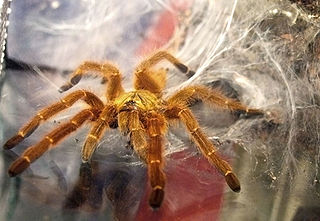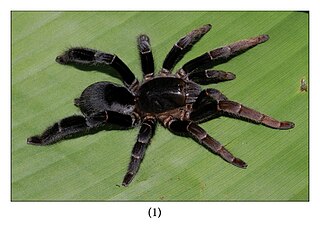
Brachypelma is a genus of spiders in the family Theraphosidae (tarantulas). They may have bodies up to 6 cm long with legs of similar or greater lengths. Some species have brightly colored legs, with red or orange marks and rings.

Brachypelma smithi is a species of spider in the family Theraphosidae (tarantulas) native to Mexico. It has been confused with Brachypelma hamorii; both have been called Mexican redknee tarantulas. Mexican redknee tarantulas are a popular choice as pets among tarantula keepers. Many earlier sources referring to B. smithi either relate to B. hamorii or do not distinguish between the two species. B. smithi is a terrestrial tarantula native to Pacific coast of the Mexican state of Guerrero.

The Harpactirinae are a subfamily of tarantulas which are native to the continent of Africa. Like many Old World tarantulas, they have a relatively strong venom and can inflict a painful bite.

Brachypelma boehmei is a tarantula native to Mexico in Guerrero state. These long-lived tarantulas prefer burrowing and hiding in dry scrubland. As with all closely related tarantula species, they defend themselves with urticating hair when provoked.

Tarantulas comprise a group of large and often hairy spiders of the family Theraphosidae. As of December 2023, 1,100 species have been identified, with 166 genera. The term "tarantula" is usually used to describe members of the family Theraphosidae, although many other members of the same infraorder (Mygalomorphae) are commonly referred to as "tarantulas" or "false tarantulas". Some of the more common species have become popular in the exotic pet trade. Many New World species kept as pets have setae known as urticating hairs that can cause irritation to the skin, and in extreme cases, cause damage to the eyes.
Hysterocrates gigas is a member of the tarantula family, Theraphosidae found in Cameroon. It is known as the giant baboon spider, Cameroon red baboon spider, or red baboon tarantula.

Pelinobius or the king baboon spider is a monotypic genus of east African tarantulas containing the single species, Pelinobius muticus. It was first described by Ferdinand Anton Franz Karsch in 1885, and is found in Tanzania and Kenya.

The skeleton tarantula, Ephebopus murinus, is a species of spider belonging to the family Theraphosidae (tarantulas), sub-family Aviculariinae. A New World species, it is native to several South American countries. Its common name is derived from the skeleton-like markings on its legs.

Brachypelma albiceps is a species of spider in the tarantula family, Theraphosidae. It is known as the Mexican golden red rump tarantula or the Amula red rump tarantula. The carapace is a light golden color and the abdomen dark, covered with long red hairs. Females typically live for about 15 years. Males usually live about 5 years or up to 12 months after the last molt.

Heteroscodra maculata is an Old World species of tarantula which was first described in 1899 by Reginald Innes Pocock. This species native to West Africa and is found primarily in Togo and Ghana. This species has many common names, of which Togo starburst and ornamental baboon are most frequently encountered.

Aphonopelma moderatum is a species of spider in the family Theraphosidae, found in United States, in the state of Texas. Commonly called the Rio Grande Gold Tarantula as they are found in the Rio Grande Valley of Texas.

Poecilotheria subfusca, or the ivory ornamental, is a spider in the tarantula family, Theraphosidae. It is endemic to Sri Lanka. As of February 2019, the World Spider Catalog regarded Poecilotheria bara as a synonym. Other sources, particularly in the pet trade, have treated highland and lowland forms as distinct species, with the lowland forms being P. bara.

Tapinauchenius plumipes, the orange tree spider, is a tarantula endemic to French Guiana. It was first described by Ludovico Di Caporiacco in 1954. Its previous name, Tapinauchenius gigas was based on the Latin word for giant, being gigas. This tarantula is often kept as a pet and commonly bred.

Idiothele mira, also known as the blue-foot baboon or the trap-door tarantula, is a species of tarantula endemic to South Africa and is popularized by hobbyists for the striking blue coloration on the ventral side of the tarsi and metatarsi on each leg. Furthermore, the species is well known for belonging to one of two described genera of theraphosids that build a trapdoor, the other being Typhochlaena.

Chilobrachys fimbriatus, commonly known as the Indian Violet Earth Tiger Tarantula usually shortened to Indian Violet Tarantula, is a species of spider of the genus Chilobrachys. It is endemic to India, and was first described by Reginald Innes Pocock in 1899.

Ceratogyrus marshalli, also known as Straight Horned Baboon or Great Horned Baboon Tarantula, is a species of tarantula from the genus Ceratogyrus. It is found in Zimbabwe and Mozambique. It was first described by Reginald Innes Pocock in 1897, as half of the Ceratogyrus genus, they own a impressive horn in the carapace.
Ornithoctonus aureotibialis is a tarantula species in the Ornithoctonus genus, it was first described by Volker von Wirth and Boris F. Striffler in 2005. It is named for the Latin, aureus being "golden" and tibia. Because of the gold or orange coloured line of hair in the tibiae of the legs in subadult and adult females and subadult males. Its common name is Thailand Golden Fringe, as the name may suggest it is found in Thailand, Myanmar and Malaysia. It is sometimes kept as a pet, and are captive bred.

Monocentropus balfouri is a tarantula in the Monocentropus genus, it was first described by Reginald Innes Pocock in 1897. This tarantula is also called Socotra Island blue baboon tarantula, usually shortened to blue baboon tarantula. This spider is named after its collector Isaac Bayley Balfour. It is found in Socotra Island, hence the common name. This tarantula is terrestrial and an opportunistic burrower. Like many tarantulas, M. balfouri can be kept as a pet, although it is not a beginner species.
Pterinochilus lugardi also known Grey starburst baboon, Dodoma baboon, Fort hall baboon or Tanzanian blonde baboon tarantula is a tarantula first described by Reginald Innes Pocock in 1900. They are found all over Southern and Eastern Africa, of course excluding Madagascar.

Lyrognathus giannisposatoi sometimes called the Sumatran stout leg tarantula is a tarantula which can be found in Mesuji Regency, Sumatra, Indonesia. It was first described by Steven C. Nunn, Rick C. West in 2013, and is named after Gianni Sposato, who helped with Selenocosmia material, and was of great help to the authors.



















